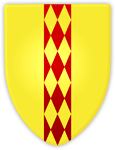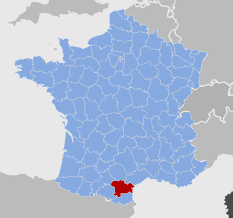A few facts about our village
Laroque-de-Fa is a French commune, located in the County (département) of Aude and the Region of Languedoc-Roussillon. Its name in Occitan is Larròca de Fan.
Laroque-de-fa is a small village located in the middle of the area of the Hautes-Corbieres. It is named in the archives at the beginning of the 11th century as belonging to Pagus Petrapertusensis, a feudal property of the Termes family which covered the current wards of Tuchan and Mouthoumet.
Its inhabitants are called les Laroquois and les Laroquoises.
The village
The village of Laroque-de-Fa is located in the middle of the High Corbieres. It is the second biggest village in the ward (canton) of Mouthoumet by its number of inhabitants (152 souls), and fourth in term of size (20,41km2). Its lowest part is at 360m altitude and its highest 849m.
The village itself has 2 parts:
The old Laroque-de-Fa:
located in the heights of the village (500m) and built in the shape of an amphitheatre around the Castelnaut rock, with the river Le Sou being its natural defence.
The low Laroque-de-Fa:
built more recently alongside the D613 at an altitude of 460m.
Surrounding hamlets
Built around the Castelnaut rock, the village is fairly concentrated. However, there are some external hamlets which are historically attached to the village:
- Les Carcassès
- South-west of the village, an old independant feudal place and Cathare castle.
- Sold to Louis the IXth by Olivier de Termes in 1260 and attached to the village in the XIXth century.
- Bordes-Grande
- West of the village in the Carcasses. An educational and ecological farm owned by the County Council and run by the Ward Council.
- Cabrol’s Mill
- North-East of the village on the way to Félines-Termenes, owned by a farmer.
- St John’s Mill (Degrave)
- At Roque Noire (Roca Negra), north-east of the village on the way to Félines- Termenes, partially restored and occupied. Old Cathare and Templar Mill of the XIII th century.
- La Baraque de Chambord
- North-east of the village on the way to Termes. The old mill is still inhabited.
History of Laroque de Fa
Origins of the name
Laroque-de-Fa, in latin Rupe de Fano or Roca de fano, means the rock of the temple.
Local and ancestral legends state that the village once had a temple dedicated to Jupiter (hence Fa for Fanum) back in Roman times. Myth or truth? Everything is possible as we now know from archeological digs that the area was used as a Roman military base for the invasion of Hispania. Several neighbouring towns like Rennes, Alet and Limoux are prime examples of Roman settlements especially as they are founded around natural thermal springs.
Prehistorical times
Evidence of human presence:
- Nécropole mégalithique de La Clape – 8 dolmens, located on the way to Massac (D1610) and then taking the left track called « de la Pintade ». The first dolmen can be found after walking about 60 metres, on the left hand side opposite a barn in ruin. Four others can be found walking up the steep slope above the path and the last two are 180 metres further on going north.
- Dolmen of Coume Jonquières – 300m on the D1610, a small dolmen difficult to find because it is covered in foliage. A cross is carved on the broken table. Middle Ages
After the invasion of the Normans, the devastating Sarrasin period as well as the neverending political conflicts, the local Lords felt the need to unite in order to defend themselves thus increasing their power and obtaining, finally, in the tenth century the rights of heritage. This marked the beginning of the feudal system.
In the Carolingian period, we see the words ‘pagus’ and ‘comitatus’ used to name wards. The current county of Aude had been split in the Roman times between Civitas Narbonae (Narbonne) and Civitas Tolosae (Toulouse).
The city of Narbonne, in the Carolingian times, was then divided into six Pagi: the Narbonnais, the Minervois, the Fenouillède, the Peyrepertuzès, the Razès and the Carcassès.
The Peyrepertuzès (Pagus Petrapertusensis) took its name from the castle of Peyrepertuse; the district included the current wards of Tuchan and Mouthoumet. Later in the XIIIth century, this pagus was then sub-divided to create Termenes, of which Laroque-de-Fa was a part of.
- The Treaty of Paris (1229) proclaimed the submission of Raymond VIIth, Count of Toulouse and the marriage of his daughter Jeanne with Alphonse of Poitiers, brother of the King Louis IXth. Alphonse died leaving no heirs so the County of Toulouse, the west part of current département of Aude, was then united to the Crown (1271).
- Raimond IInd Trencavel, Viscount of Carcassonne, acquiesed to powers of the King (1246-1247) thus bringing the central part of the current departement of Aude into the royal realm. The rest was annexed in 1258 by decree from King Jacques of Aragon, King of Majorca to Louis IX.
- Laroque-de-Fa, part of the much disputed land argued over by the Abbey of Lagrasse and the Lords of Termes, was then sold to the King Louis IX by Olivier of Termes.
- In 1167, Bernard of Balbonne was the Lord of Laroque-de-Fa
- In the great Occitan revolt (1240) Olivier of Termes was besieged in Laroque-de-Fa by the King’s troops .
- The domain of Carcassès was sold to the King in 1260 by Olivier of Termes.
- The Commander of the Temple ofNotre-Dame de Peyrens administered justice in Laroque-de-Fa (1273-1285)
- Françoise of Arse, Lordship in part (1557)
- Jean of Montredon, Lord in 1607
- 1695 Bernard of Barre purchased the domain of Laroque-de-Fa from the King
Religious sites
Church of Saint-Cyr and Sainte-Juliette
A structure with a rectangular nave arched in a cradle, with two double arched bays. The basis of the vault is underlined by a moulded decorative banner. The square chancel is vaulted with an intersection of arches sitting on a marble base. The nave dates from the end of the 12th century and the chancel from the end of the 13th century..
In the 19th century, two chapels were added. The South Chapel, dedicated to the Virgin Mary, houses a 17th or 18th century listed statue of the Virgin Mary with infant Jesus carved in wood and gilded . The North Chapel is dedicated to Saint Joseph but his gilded statue is located above the porch. The chancel houses a 17th century statue of the crowned St Juliette and St Cyr, holding hands and each carrying a palm.
At the end of the 19th and beginning of the 20th century all the windows were fitted with stained-glass. The stained-glass window north of the chancel represents St. George overcoming a dragon; the stained-glass window to the south represents Saint Roch and his dog and the oculus above the porch, the Sacred Heart.
The door in the vault would have previously been a porch. Above it is a small church tower with two bells. The church and its 2 statues were fully restored in 1975. During the restoration, an old Devonian chalk altar was discovered and placed on a stone base where it remains.
Église Sainte-Marie-Magdeleine
South of the village the ruins of the old church of the Carcasses, dedicated to St Mary Magdeleine, can be found amidst foliage and vegetation.
Fauna and flora around Laroque-de-Fa
Vegetation
The flora around the village is mainly of broad-leaved trees, pines and scrubland:
- Holm oaks
- Elms
- Juniper
- Cork oaks
- Willow trees
- Wild thyme
- Chesnut trees
- Box trees
- Heather
- Beech trees
- Broom
Nature is giving also alongside the tracks and paths in our steep hills, several types of wild fruits especially the so called white fig can be found in profusion (very good for jams and to accompany any poultry dish):
- Chesnuts
- White figs
- Wild plums
- Almonds
- Wild pears
- Medlar
- Elderberry
- Walnuts
- Blackberries
Autumn gives us lovely copper and orange landscapes and underneath those leaves you can find several varieties of delicious mushrooms:
- Chanterelles
- Roussoulloux
- Morels
- Horns of plenty
- Meadow mushrooms
- Pieds bleus
- Cepes
- Parasol mushrooms
- Pieds de mouton
Animals of all kinds
Please find a list of animals that you will often come across in the area:
Aquatic species
- Eels
- Fario trout
- Crayfish
- Barbels
- Minnows
- Frogs
- Daces
- Gudgeons
Flying species
- Harriers & buzzards
- Fauvette
- Owls
- Wild ducks
- Falcons
- Partridge
- Woodpigeons
- Blue tits
- Boneli eagles
- Swallows
- Woodpeckers
- Robins
- Cochevis de Thékla
- Quail
- Hoopoes
- Bats
Terrestrial species
- Hegdehogs
- Vipers
- Squirrels
- Hare
- Foxes
- Grass snakes
- Wild boars
- Deer
- Lizard
- Polecats
Insects
As well as some very common insects like bees and wasps you will also encounter Praying Mantis, Maybugs and an incredible amount of butterflies of all shapes and colours.

 English
English
 Français
Français